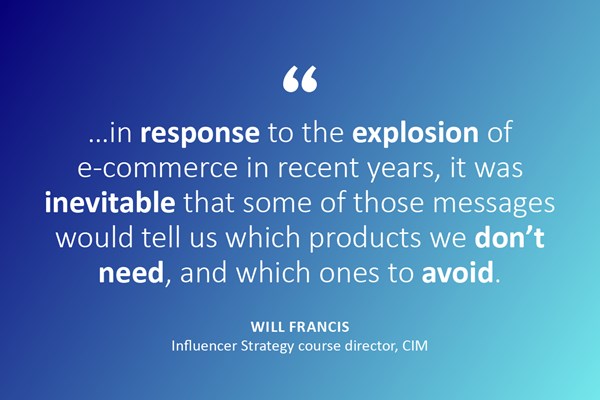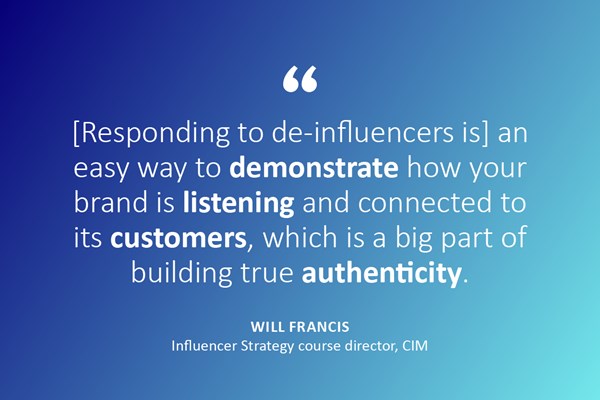What is the de-influencing trend?

- 16 May 2023
Marketing trends can come and go. But is the de-influencing trend here to stay? CIM course director, Will Francis, gives us his insight and we take a look at where this trend seemingly sprung up from, why it's grown in popularity and the affect it's having on influencer marketing as we know it.
In the search for authenticity, people are turning their backs on traditional influencing and looking towards a trend which started to gain traction in December called “de-influencing”. The popularity of this trend has soared on Tiktok, with the hashtag de-influencing appearing on over 160 million videos.
What marketers are seeing cropping up again and again is that consumers want authenticity. In a survey of 1,590 consumers by Stackla, 90% say that authenticity is important when supporting a brand.
Does influencer marketing pique your interest? If you'd like to know how you can use influencer marketing for your business, register for our Influencer Strategy training course.
What is influencing?
If you’re on social media it’s highly likely that you’ll have encountered influencers of all kinds. These include celebrities, industry experts, micro-influencers and bloggers and content creators. According to Hubspot, 1 in 4 marketers currently apply influencer marketing in their strategy.
Influencer Strategy course director, Will Francis, explains people will sometimes choose to be a “beacon for a certain tribe” in who they support and trust, leading others to brands which align with their values and beliefs.
Influencer marketing is when brands work with influencers who have knowledge, insight or authority in a certain subject. Being pre-existing influential figures in their niche subjects makes them a great source of reliability and credibility. Content posted by brands themselves can be seen as more contrived and is less trusted than user generated content.
In research shown on YPulse, 53% of 13-36-year-olds say they browse through social media to find things they want to buy and with this inspiration they might support the brands promoted.
Influencing sometimes isn’t as transparent as people may think: someone might be advertising mascara, but they might wear false eyelashes most of the time, and in fact wearing them in the mascara content itself. This lack of honesty has led some to turn to de-influencers for their honest, up-front opinions.
What is de-influencing?
“De-influencing began as an attempt to use social media to promote understanding about the close relationships between fast-fashion, fast-beauty, and unethical labour exploitation and the profligate utilisation of resources” explains Alex Carapiet, head of social at student and Gen Z marketing agency Seed.
“In its simplest form it boils down to people giving their opinions and views” Will Francis says. “This is not a new thing to come along, people have always given product reviews. But in response to the explosion of e-commerce in recent years, it was inevitable that some of those messages would tell us which products we don’t need, and which ones to avoid.”
With audiences starting to question the reviews which so often pop up on our feeds, what we desire more than ever is authenticity. There are growing trust issues between influencers and audiences, in answer to this, the de-influencer was created. But why would someone choose to be a de-influencer?
Why are audiences turning to de-influencing?
In essence, the idea of de-influencing is the antidote to the challenges we face today.
Smaller content creators created de-influencing as a they had less to lose than bigger creators who might actively work with brands to promote products.
Many people have chosen the de-influencer path for many reasons including:
- Overconsumption
- The cost-of-living crisis
- Sustainability
- To bring some authenticity to social media
The ‘don’t waste your money’ theme is a common reason for those de-influencing. The unnecessary consumption of products, adding to more production and in turn more waste which can’t be broken down and recycled is a huge factor in people becoming and listening to de-influencers
The cost-of-living crisis is a huge factor in driving people towards de-influencing. Being constantly bombarded by images of products, being told that to feel happier, healthier and other such things, people have been feeling more pressure to consume. However, consumers are under much more tighter constraints financially now. Spending on products which aren’t effective and don’t work well has a greater impact on people. We want to spend on items which add value to our lives and finding people who will give honest reviews of a product is very attractive.
The draw to ‘ordinary’ shoppers rather than influencers is clear as research by Nosto, a customer experience platform, indicates that 79% of an audience find this has a strong effect on their buying decisions, whereas only 9% say that content created by influencers as much of an impact.
An Honest Review?
Consumers are asking for more honesty and transparency from brands, this includes the from the people working and representing them online. De-influencers create the persona that they are on the side of the audience, offering an impartial and unbiased point of view.
But is it unbiased? Could it be that de-influencers are tapping into the bias that we have in believing the negative over the positive? Perhaps by tugging at our tendency to trust a more negative review and ere on the side of caution, de-influencers can gain more viral success.
However, Jago Sherman, head of strategy at the social media marketing agency Goat said in a recent article on The Guardian website “The controversial statements are the ones that get more engagement because people comment”. By expressing more extreme views, de-influencers have trended and become virally successful.
Will Francis gives an insight into the power of negativity versus positivity “In copywriting, it is often more of a draw to use negative headlines rather than positive. If someone uses the title ‘5 Things You Need in Your Apartment’ this can create some interest. However, ‘5 Things You Don’t Need in Your Apartment’ is a far more clickable headline. Words like ‘avoid’, ‘never’, ‘don’t’, ‘stop’ etc have real power”
Does it matter why people are engaged in your content?
More engagement proves “your content is resonating with the people who see it” and more visibility on social media to reach a wider audience means more potential fans.
De-influencers could be seen as sacrificing their marketability for engagement, but perhaps the pursuit for authenticity overrides any potential business they are losing.
Giving the consumer the choice
If a brand is targeted by a de-influencer, Will Francis says that “this is an opportunity to respond and show both confidence and openness in joining that conversation. It’s an easy way to demonstrate how your brand is listening and connected to its customers, which is a big part of building true authenticity”.
As written on The Drum website “Brands should embrace emerging content, collaborate with partners wisely and continue to move with the trends to remain relevant.”
The marketing industry is constantly evolving, and this means various channels of it too. Brands and individuals taking advantage of opportunities like this is nothing new. Giving the audience a choice is a power move for both consumer and brands.
If you're looking to up your social media strategy, learn more about how influencing can help your business on our Influencer Strategy training course.

- 0 views

 FAQs
FAQs
 Log in
Log in
 MyCIM
MyCIM








